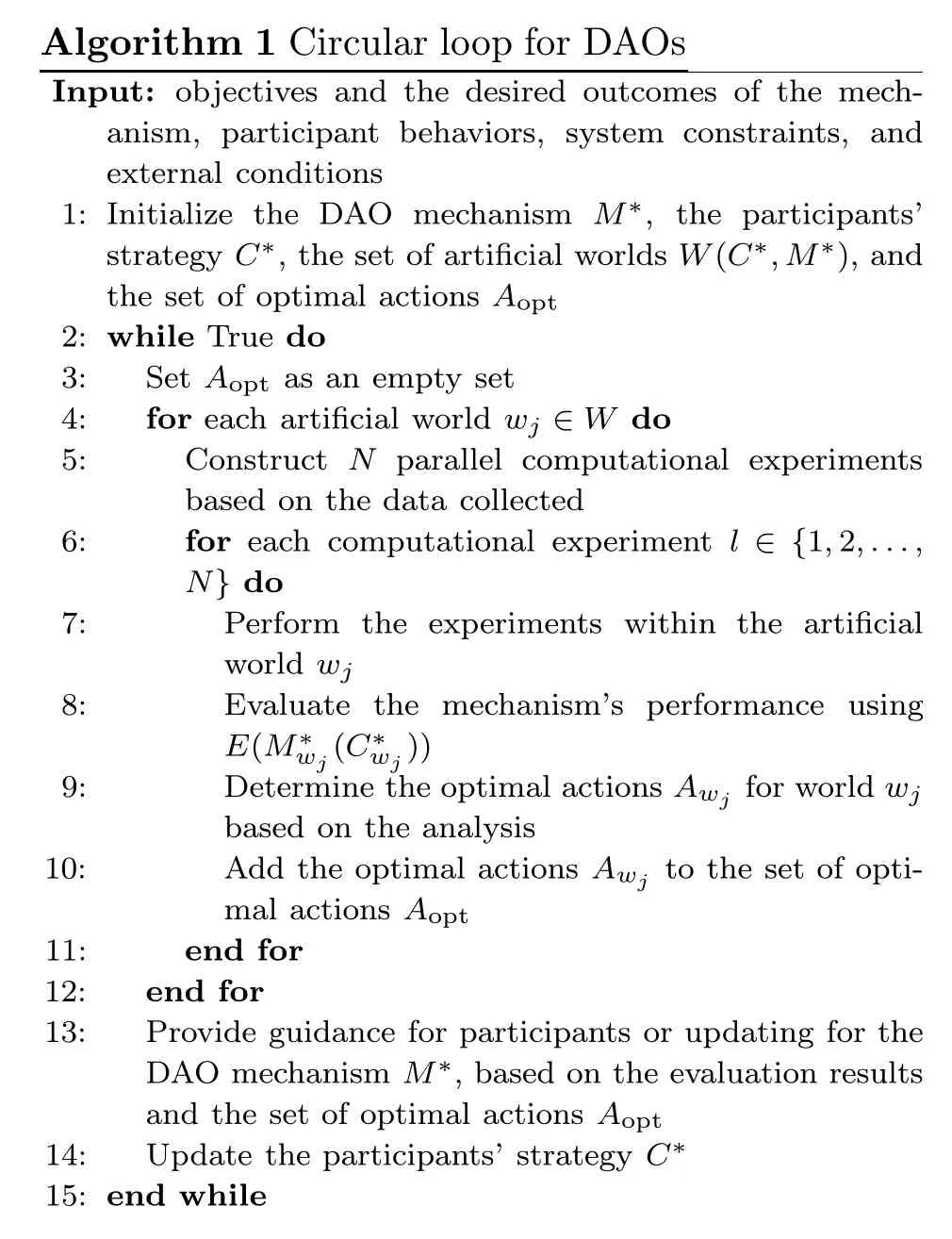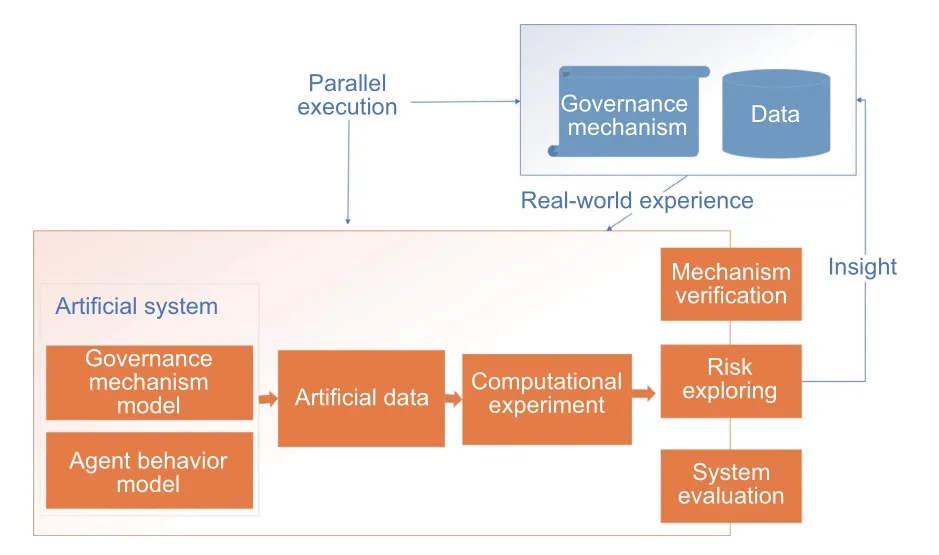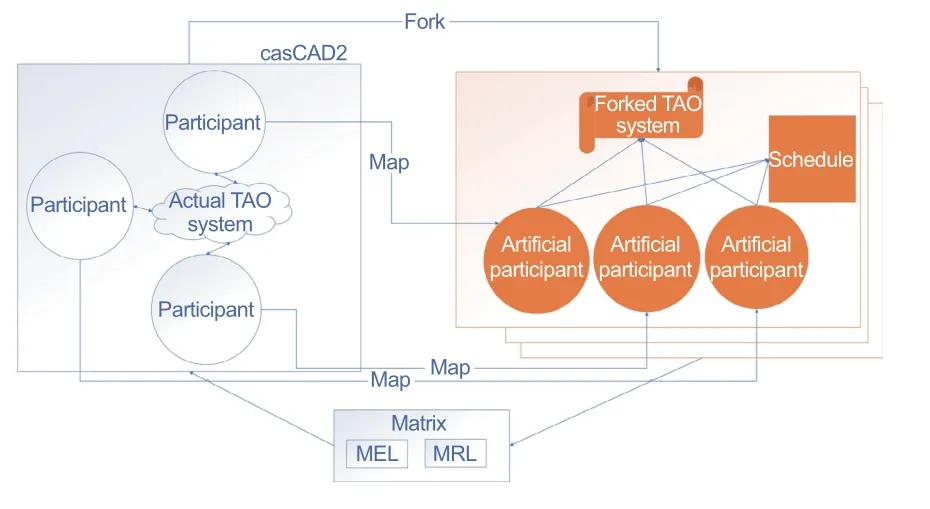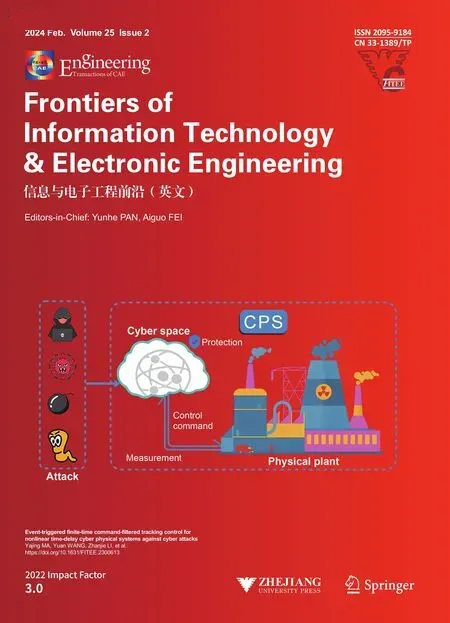The engineering of circular causality for specialization and design of complex systems:cad2CAS and casCAD2?
Xiaolong LIANG ,Rui QIN ,Juanjuan LI ,Fei-Yue WANG
1Faculty of Innovation Engineering, Macau University of Science and Technology, Macao 999078, China
2State Key Laboratory of Multimodal Artificial Intelligence Systems,Chinese Academy of Sciences, Beijing 100190, China
3The State Key Laboratory for Management and Control of Complex Systems,Chinese Academy of Sciences, Beijing 100190, China
The emergence of decentralized autonomous organizations and operations (DAOs),equipped with innovative mechanisms,enables new possibilities for transforming traditional social collaborative relationships.Mechanisms are the underlying driver for DAOs.However,as a complex system encompassing both social complexity and engineering complexity,DAO mechanisms need to dynamically adapt to the changing external environment.Traditional top-down approaches cannot effectively deal with these problems.The circular causality theory views the operation of complex systems as a continuously evolving dynamic process,providing new perspectives to address these challenges.This paper proposes an engineering methodology grounded in the principles of parallel intelligence and circular causality theory to develop and specialize DAO mechanisms.Computer-aided dynamic design for complex adaptive systems(cad2CAS)is employed to streamline the design of DAO mechanisms and the complex adaptive system for computer-aided dynamic design (casCAD2) is used to verify and guide these mechanisms,thus establishing a causality loop.By proposing this methodology,we aim to enhance the efficiency,security,and adaptability of DAO governance systems,laying the foundation for more robust and resilient decentralized organizations.
1 Introduction
DAOs represent a revolutionary shift in structuring social collaborative relationships guided by the idea that code is law(Liang et al.,2021;Li et al.,2023a,2023b).This innovative organizational form aims to establish a democratic paradigm,thereby addressing various issues encountered in traditional organizations,such as bureaucracy,principal-agent problems,and contract risks(Wang FY et al.,2022a,2022b;Weyl et al.,2022).To achieve this objective,DAOs employ meticulously designed governance and incentive mechanisms to manage interactions among members (Li et al.,2021;Qin et al.,2023).For example,Kleros uses a token-based judge selection procedure and a one-person-one-vote system,ensuring fair decision-making.Gitcoin implements quadratic voting to engage donors actively and enhance democratic involvement.Additionally,GnosisDAO embraces Futarchy as a governance strategy,fostering informed decisions and efficient resource distribution.
DAO mechanism design has been widely discussed in industry but has not received enough attention in academia.Existing research on DAO mechanisms focuses mainly on DAO governance issues(Kondova and Barba,2019;Rikken et al.,2019)and associated mechanism design (Yuan and Zeng,2012;Chohan,2017),as well as DAO architectural design (Kaal,2021).However,these studies tend to view DAO mechanism issues from a governance perspective,resulting in a lack of holistic control over DAOs’ entire lifecycle.In the industrial realm,related works primarily manifest in the form of community discussions or project-based investigations,such as cryptoeconomics proposed by Vitalik and token engineering suggested by the“Token Economy Academy.”
Introduced by Vitalik in 2016,cryptoeconomics has become a discipline in the cryptographic field,providing a systematic framework for designing decentralized systems.However,it does not fully address the problem of system complexity.Token engineering,which employs engineering principles and tools like complex adaptive dynamics computeraided design (cadCAD) (Zhang et al.,2020) to model,simulate,and test key components of decentralized systems,also struggles to adapt to unforeseen challenges and situations.
Parallel intelligence provides an efficient approach for modeling complex systems (Wang FY,2004;Wang JC et al.,2023).Through the parallel execution and closed-loop feedback between artificial and actual systems,this approach enables the creation of more resilient,adaptable,and effective DAO mechanisms (Qin et al.,2020;Wang FY et al.,2022c),contributing to the refinement of decentralized governance structures and their realworld applicability.Building upon this,parallel governance emerges as a comprehensive framework for DAO governance,capable of modeling artificial systems,conducting computational experiments,and making predictions (Ding et al.,2021).However,parallel governance focuses mainly on specific governance issues,without considering the entire lifecycle of DAO mechanisms.To address these gaps,this paper proposes a more comprehensive and flexible mechanism design framework based on the parallel intelligence theory,which aims to enhance the effi-ciency,security,and adaptability of DAO governance systems,laying the groundwork for more robust and resilient decentralized organizations.The contributions of this paper are as follows:
1.This paper introduces a novel method for mechanism design,verification,and guidance,grounded on the parallel intelligence and circular causality theory,and also discusses its theoretical foundations and application challenges.
2.Using cad2CAS and casCAD2 tools,this paper delineates the engineering pathway for this method,with a case study serving as a practical demonstration.
3.This paper presents a unique viewpoint on mechanism design,interpreting it as a dynamic and iterative process.
2 Theoretical framework: circular causality of DAO mechanisms
Circular causality refers to the mutual influence and interaction between various parts of a complex system,forming a closed-loop causality chain (Zeigler et al.,2000).This phenomenon includes two types of feedback loops: positive and negative.Positive feedback loops serve to amplify or reinforce an initial action or event,while negative feedback loops work to stabilize or dampen the effects by counteracting them.The feedback loops connect components in a complex system,thus determining the evolution of the system.Therefore,feedback loop engineering is the key to constructing robust and adaptive systems.
DAO mechanism system often deals with constantly changing environments,highly complex situations,and unprecedented scenarios.As a dynamic system,an ad-hoc mechanism for special purposes may cause unpredicted feedback,leading the system to an unwanted state.In contrast,a welldesigned mechanism should use the feedback loops,guiding the system toward a more favorable trajectory.Mechanism setup and governance are crucial steps in creating such loops,and they define the rules and processes that dictate the system’s behavior.The setup stage sets up the initial feedback structure.The governance stage then details how the feedback loops guide interactions between components to achieve the intended system-level behavior.
2.1 Setup loop of DAO mechanisms
The ultimate aim of DAO mechanism setup is to establish a system of interaction and incentivization among participants within a decentralized setting.This system enables individuals within the organization to pursue their personal interests while concurrently guiding them toward a convergence point,where the interests of both the organization and the individual align harmoniously(Yuan and Wang,2018;Braun et al.,2021).To successfully achieve this objective,DAO mechanisms require careful consideration of multiple factors,including the power structure,value flow,and decision-making method.
This objective can be expressed as follows:
whereFrepresents the social choice function,which maps individual preferences to collective preferences and serves as the goal that mechanism designers strive to achieve during the design process.M,on the other hand,signifies the mechanism augmented with necessary incentives,directing participants to behave in accordance with the mechanism designer’s intention and attain the desired outcomes.Crepresents the strategy vector of all participants and“diff”represents a function used to calculate the difference or divergence between the two outputs.
For a given mechanismM,its effectiveness stems from the strategic choices of the participants.That is,the mechanism design must ensure that the optimal strategy for participants aligns with the mechanism’s intended strategy.Letcirepresent the strategy of participanti,withvidenoting the participant’s utility function.For any participanti,the optimal strategyconstantly maintains
whereCirepresents the strategy set of participanti,withθrepresenting other variables and parameters that may influence the strategic choices and preferences of participantiwithin the mechanism.
Then the participants’ strategies can be expressed as follows:
The optimal solution for a mechanism often needs to be obtained through the addition of extraeconomic incentives (Jackson,2014).In DAOs,token-based incentive mechanisms use economic effects as an important means to incentivize members,and these mechanisms will be updated by democratic voting.
The setup loop thus forms a causality chain that can be represented as
The chain indicates that the mechanism can influence user behavior by offering incentives,while user behavior can also affect the design and validation of the mechanism.
2.2 Governance loop of DAO mechanisms
In the governance stage,we evaluate whether the mechanism functions by finding maximum global loss satisfy the requirements:
whereE?denotes the potential maximum loss.
Using the global lossE,a governance methodology for virtual-real interactions based on the parallel intelligence theory can be established(Wang FY,2004,2010),which can be used to assess and explore potential systemic risks of the actual system through the artificial environments,to mitigate the onset of adverse cycles and promote the progression of beneficial feedback loops.The process can be as shown in Eq.(6):
whereA?denotes the most favorable set of potential actions,which may include the fine-tuning of system parameters,alterations to system mechanisms,and implementation of risk-averse strategies within the system.
However,determiningEmay be challenging due to the different organizational forms and governance mechanisms of DAOs.Generally,the goals of DAOs can be divided into two main aspects: ensuring their own continuity and realizing their pre-set goals when they are established.Considering these two aspects,effectiveness and robustness can be adopted for assessing the DAO mechanism,as shown in Eq.(7):
Effectiveness loss of DAO mechanism (MEL):Governance effectiveness compares a DAO mechanism’s output to its designers’ desired utility function,assessing aspects such as voting activity,decision quality,and fairness.The formula of MEL is given in Eq.(8):
Robustness loss of DAO mechanism(MRL):Robustness reflects a mechanism’s reliability and its ability to maintain effective governance under various extreme conditions,including security,stability,resilience,adaptability,and sustainability,as presented in Eq.(9):
where MELirepresents the governance loss in theithrepetition of the experiments andrepresents the average governance loss acrossnrepetitions.
Thus,the operation loop can form a causality chain as follows:
The chain suggests that actions and DAO’s global loss are mutually reinforcing.An appropriate governance strategy can generate positive feedback,while an incorrect strategy could lead directly to the collapse of governance.
2.3 Circular causality of DAO mechanisms
The circular causality method of mechanism design is shown in Fig.1.In the process of mechanism setup,circular causalities are captured by simulating different participant behaviors,system constraints,and external conditions.It entails the establishment of a causality loop between the DAO mechanism and the behaviors of participants.

Fig.1 Causality loop in DAO mechanism design
In response to the actions of participants,the DAO mechanism undergoes updates,thereby approximating the desired outcome delineated by Eq.(1).
Subsequently,the governance stage encompasses the validation and guidance stage.During this stage,a system of verification and guidance is implemented with the express purpose of engendering positive feedback within the causality chain of the mechanism.The verification process is carried out in accordance with Eq.(5),while the guidance adheres to Eq.(6).
By integrating the setup loop and governance loop of mechanisms,we can establish a cyclical and iterative method for mechanism design,evaluation,and guidance,drawing on the theory of parallel intelligence.Both of these two stages are realized through the construction of multiple artificial worlds,parallel execution,and feedback,as illustrated in Algorithm 1.In the mechanism design phase,artificial worlds are constructed based on assumptions,and modifications to the system mechanism are made directly by the designers.Conversely,in the governance phase,artificial worlds need to be constructed based on real-world data,and guidance is given to direct the governance of the actual system.In this way,mechanism design is not treated as a static process but as an evolving complex dynamic system.
3 From cad2CAS to casCAD2: an engineering view
In this section,the application of the aforementioned theory to mechanism design will be demonstrated from an engineering view.Notably,cad2CAS and casCAD2 will be employed in the construction of the proposed framework(Liang et al.,2023).
The entire lifecycle of DAO governance mechanisms includes design,development,audit,testing,deployment,updates,and guidance governance,with each step being interconnected to ensure the effectiveness of DAO mechanism design.During the mechanism design and development process,cad2CAS provides artificial data and experimental support for mechanism modeling and analysis by constructing multiple parallel artificial worlds.In the governance process,casCAD2 monitors critical indicators of the mechanism in real time and guides the DAOs toward the optimal directions.

3.1 Setup loop with cad2CAS
Cad2CAS aims to find the optimal solution for a mechanism design by integrating virtual and realworld methodologies,consequently reducing uncertainty risks.Cad2CAS is constructed based on the parallel intelligence theory,using an agent-based modeling approach,segmented into four distinct modules: agent module,mechanism simulation module,computational experiment module,and analysis module.The agent module uses a bottom-up approach to model the behaviors of each participant.Conversely,the mechanism simulation module models the mechanism systems of DAOs through mathematical models,code simulations,and other methods.The computational experiment module generates artificial data by constructing artificial worlds and launching computational experiments,whereas the analysis module is used for the evaluation of those data.
To improve the design,cad2CAS constructs multiple artificial systems that run in parallel with the actual system and conducts various computational experiments within the artificial systems,as shown in Fig.2.In this way,cad2CAS can continuously search for potential issues in the system through iterative optimization methods.The results that may evolve from different users’choices will be calculated and abstracted into precise knowledge for improving the actual system.This process will iterate continuously before the mechanism officially goes live.

Fig.2 Operational logic and workflow of cad2CAS
3.2 Governance loop with casCAD2
Once the mechanism design is complete,cas-CAD2 can be employed to construct a mechanism governance feedback loop to guide the iteration of the mechanism toward an optimal direction.Cas-CAD2 constructs a mechanism evaluation system to monitor various indicators of DAOs in real time and provide governance guidance based on artificial data.The overall architecture is shown in Fig.3.

Fig.3 Operational logic and workflow of casCAD2
In casCAD2,a forking method is used at regular intervals to replicate the original data,thereby constructing multiple artificial worlds with different parameters.Computational experiments can then be launched in these artificial worlds.CasCAD2 provides a mechanism for predicting potential future developments from the current state.The predicted results are then fed back to the real DAO system,serving as guidance for the governance and mechanism updates of DAOs.By integrating the insights derived from the artificial world with the real world,casCAD2 can guide the system to construct a virtuous causality loop,thereby continuously optimizing mechanisms and systems.
4 Case study
To illustrate how the proposed method can be applied in real-world scenarios,we use the marketbased anchoring mechanism (MAM) (Liang et al.,2023) as an instance,and launch two experiments with cad2CAS and casCAD2.
MAM is designed to minimize the price disparity between the actual and synthetic assets.A synthetic asset is a digital derivative of a real asset,often known as a cryptocurrency(Neftci,2002;Jensen et al.,2021).The MAM sets up a stable token SUSD,a platform token SMAMT,and a synthetic asset token SAsset.Different tokens or synthetic assets can swap between each other,the exchange ratio of SUSD and SMAMT is fixed to 1:1,and the exchange ratio of SMAMT and SAsset is determined by the price ratio between the corresponding real assets and SMAMT.
Thus,when the price of virtual assets is different from that of the corresponding real assets,users can profit by swapping between different tokens.The design goal of this mechanism is to relatively bind the price between the real assets and virtual assets.MAM is shown as follows:
wherepiis the price of the synthetic corresponding to asseti,i=1,2,···,n,andis the price of the actual asseti.
4.1 Setup loop of MAM
To enhance the MAM,we pre-construct five categories of user behavior patterns according to the assumptions of mechanism design.Each category is characterized by a distinct strategy:
1.SMAMT holders: This type of agent consistently accumulates and retains SMAMT until it reaches a predefined limit.
2.SAsset holders/Liquidity providers: This type of agent continuously purchases SAssets and engages in liquidity mining once the profits from this operation surpass a predetermined threshold.
3.SAsset bullishers: This type of agent persistently purchases SAssets and opts to sell them when the price drops beyond a percentage.
4.SAsset bearishers: This type of agent regularly acquires SAssets and sells them when the price surges beyond a percentage.
5.Short-term speculators: This type of agent buys or sells SAssets when the price difference between the SAsset and its corresponding real-world asset is large enough to guarantee a defined profit.
Subsequently,based on design requirements,a set of candidate mechanisms will be set up.In this case,an automated market maker is needed to provide an exchange function between different tokens.To design and evaluate the market mechanism,we set up a collection of available candidates and carry out a series of computational experiments for validation.In this study,the logarithmic market scoring rule (LMSR) and the constant product market maker (CPMM) are used as an example.The MEL as shown in Eq.(8) and the MRL as depicted in Eq.(9)are used to measure the mechanism.
Fig.4a illustrates the variation in two types of loss in DAOs as the number of iterations increases.In Fig.4b,the area above the curve represents the proportion of artificial worlds choosing the CPMM mechanism,while the area below indicates the proportion opting for the LMSR mechanism.The results show that neither of the two market mechanisms exhibits a significant difference in performance.However,CPMM offers a simpler calculation process,leading to its selection.This choice in turn influences assumptions about the agents,which can subsequently affect the design of subsequent mechanisms.

Fig.4 Experimental results of MAM setup loop with cad2CAS: (a) changes of MRL and MEL during the iterations;(b) changes of market maker proportion during the iterations
4.2 Governance loop of MAM
In the case of MAM,multiple artificial systems will be created with the same status as the actual one.The user account balances,market liquidity balances,and exchange rates between different tokens prevalent in the artificial world would be consistent with those in the real world.User behavior models and mechanisms can be set through a random search algorithm,allowing for the prediction of various indices of the mechanism under different scenarios.We conduct a computational experiment to analyze how the behavior of different agents could potentially influence the system.
Fig.5 suggests that an enhancement in incentives for short-term speculators is necessary.Because as the number of short-term speculators decreases,the effectiveness of the mechanism is likely to diminish.The guiding information will be disseminated to all governance members of MAM,serving to assist members’decision-making process.

Fig.5 Experimental results of MAM governance loop with casCAD2: (a) changes of MRL and MEL during the iterations;(b) changes of agent proportion during the iterations
5 Challenges and future research
5.1 Challenges
This study establishes a dynamic mechanism engineering method grounded in the parallel intelligence and circular causality theory.However,due to the inherent social and engineering complexity of DAOs,the application of this method may face a series of challenges.
5.1.1 Complexity of modeling DAO system
The method necessitates modeling of the overall DAO system and participant behaviors.However,the complexity of the model,particularly in relation to the mechanism and the participants,poses a significant challenge.DAO mechanisms often encompass multiple intricate steps.For instance,DAO governance mechanisms typically consist of procedures such as proposing,voting,disputes,arbitration,and execution,each of which is composed of multiple contracts.User behaviors during these processes are difficult to predict.Although DAOs are designed with assumptions about user behaviors,predicting users’behaviors in a DAO still is a significant challenge due to their inherent uncertainty and the dynamic nature of the environment.A potential approach is the combination of reductive modeling and unified modeling.When modeling participants,the goal is not to reproduce real-world scenarios in their entirety,but instead to adhere to consistent patterns.Furthermore,the facilitation of interaction between virtual and real data guides the two systems toward convergence.
5.1.2 Data availability and quality of DAOs
The method requires high-quality,usable data from actual DAO environments to assist in adjusting artificial models.However,such data are not always available in practice.While DAOs,as open organizations,have their source code and operation records logged on the blockchain for public access,the operation of DAOs involves a variety of multi-modal data and is challenging to correlate and process.Moreover,the communication data,such as social media data,may not be directly obtained.Consequently,the implementation of the method is also constrained by data availability and quality.The issue can be ameliorated by constructing data governance mechanisms and offering corresponding incentives.
5.1.3 Cost of governance loop
The method,based on the parallel intelligence theory,employs a virtual real interactive,bidirectional guidance approach for iterative governance of DAOs.This necessitates providing useful information for reasonable guidance of members.However,governance guidance in the complex environment of DAOs is not intuitive and requires users to understand the underlying mechanisms and logic,which can be a barrier to entry.On the other hand,this method inherently demands extra computational resources,and these requirements increase as the scale of the DAO expands.Therefore,developing efficient strategies for providing guidance without overwhelming users is a significant challenge.However,the improvements brought about by the governance loop can offset these expenditures.Furthermore,a well-structured guidance scheme can reduce the difficulty of user participation.
5.2 Future research
This study establishes the theoretical framework for the circular causality based method,but there are some research issues that require further exploration.
5.2.1 Measurement matrix of DAOs
Research on the measurement matrix of DAOs can be launched from three distinct angles.First,the effectiveness of individual governance can be considered.This will assess the quality of consensus reached among individuals in the organization,and an example might be the voting pass rate.Second,future studies could evaluate the outcomes of group governance.Here,the focus could be on the direction of organizational development and the efficacy of incentives.For this purpose,a practical measure might be the level of vitality in governance and the degree of decentralization.The MEL and MRL also fall under this category.Third,future research could incorporate the perspective of ecosystem governance,which involves the consideration of an organization’s position within the ecosystem.Factors to be considered may include the scale of DAO,its role within the ecosystem landscape,and the amount of capital it holds.
5.2.2 Ethical influence of DAO designing
DAOs use code-based governance to organize collaboration between humans and machines.However,rule-based algorithms may struggle to accommodate human ethical needs.For example,in a situation where the algorithm makes a decision that is technically correct but ethically questionable,a purely rule-based algorithmic approach could lead to ethically unsatisfactory outcomes.This could be situations where majority rule infringes on the rights of minorities,or where strict adherence to rules does not allow for mercy or compassion in exceptional circumstances.Additionally,issues related to algorithmic bias and fairness could arise.Without careful design and regular review,algorithms can unintentionally perpetuate or amplify existing biases,leading to unfair outcomes.Undesirable outcomes from a mechanism can lead to a loss of confidence amongst members,thereby affecting the development of DAO organizations.
To mitigate the identified issues,comprehensive testing and iterative refinement of mechanisms should be employed during the design phase.Furthermore,as a step toward ensuring that decisions beyond the handling capacity of machines are delegated to humans,the introduction of human intervention is recommended.Consequently,designing hybrid human–machine decision-making mechanisms to resolve ethical issues is one of our future works.
5.2.3 Potential applications of DAOs
As a novel manifestation of democratic principles,DAOs have the potential to revolutionize human collaboration.However,most existing DAO mechanisms are centered around virtual currency(Liang et al.,2021).They lack applications that impact actual production processes,but the bottomup organizational structure and decentralized equity structure of DAOs are suitable for many industries,such as finance,creative industries,and research.Hence,exploration of the application of DAO in potential application fields constitutes our future research.
6 Conclusions
In this paper,we presented a dynamic iterative method for the engineering of DAO mechanisms.We discussed the method from both theoretical and engineering perspectives and employed a case study to demonstrate how the proposed method can be applied in real-world scenarios.This approach can assist users in establishing robust,secure,and efficient mechanisms.Additionally,it uses artificial data to guide mechanism governance,thereby enabling a positive feedback loop of cause and effect,and steering the system towards continuous optimization and improvement.However,due to the inherent social and engineering complexities of DAOs,practical applications may face issues such as model complexity,the lack of guaranteed data quality,and excessively high governance costs.Moreover,further research is required in areas like the development of a more comprehensive evaluation metric system,the impact of ethics on mechanism design,and practical applications.
Currently,DAOs are still in the early stages,and further research on the organizational structure,governance mechanisms,and practical applications is still necessary.By providing a mechanism engineering method based on the parallel intelligent and circular causality theory,we hope to offer theoretical and practical support for scholars and engineers in related fields.
Contributors
Xiaolong LIANG and Fei-Yue WANG designed the research.Xiaolong LIANG and Rui QIN conducted the analysis and drafted the paper.Xiaolong LIANG,Rui QIN,Juanjuan LI,and Fei-Yue WANG revised and finalized the paper.
Compliance with ethics guidelines
Fei-Yue WANG is an editorial board member ofFrontiers of Information Technology&Electronic Engineering,and he was not involved with the peer review process of this paper.Xiaolong LIANG,Rui QIN,Juanjuan LI,and Fei-Yue WANG declare that they have no conflict of interest.
Data availability
The data that support the findings of this study are available from the corresponding author upon reasonable request.
 Frontiers of Information Technology & Electronic Engineering2024年2期
Frontiers of Information Technology & Electronic Engineering2024年2期
- Frontiers of Information Technology & Electronic Engineering的其它文章
- Secure control and filtering for industrial metaverse
- A low-noise,high-gain,and large-dynamic-range photodetector based on a JFET and a charge amplifier*
- A novel topology with controllable wideband baseband impedance for power amplifiers?
- Empowering smart city situational awareness via big mobile data?
- Asynchronous gain-scheduled control of deepwater drilling riser system with hybrid event-triggered sampling and unreliable communication?#
- Estimation of Hammerstein nonlinear systems with noises using filtering and recursive approaches for industrial control*
